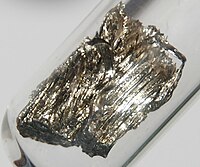
Photo from wikipedia
Abstract Tm3+-Dy3+ co-doped and Tm3+-Dy3+-Eu3+ tri-doped glass-ceramics (dGCs) containing NaY(MoO4)2 crystal phase were prepared. The crystal phase of the GCs was determined to be NaY(MoO4)2 by XRD, and the optimal… Click to show full abstract
Abstract Tm3+-Dy3+ co-doped and Tm3+-Dy3+-Eu3+ tri-doped glass-ceramics (dGCs) containing NaY(MoO4)2 crystal phase were prepared. The crystal phase of the GCs was determined to be NaY(MoO4)2 by XRD, and the optimal heat treatment condition of GCs was determined to be 670 °C/2.5 h by DSC, SEM, and transmittance curves. Under 362 nm light excitation, the chromaticity coordinates of the Tm3+-Dy3+ co-doped GCs were tuned from blue to white region by adjusting the Dy3+ concentration. The energy transfer (ET) mechanism from Tm3+ to Dy3+ was a dipole-dipole interaction, and the ET efficiency was as high as 56.3% when the concentration of Dy3+ was 1.1%. When the concentration of Dy3+ exceeds 1.1%, concentration quenching caused by interaction between nearest-neighbor ions can be observed. With the addition of Eu3+, the chromaticity coordinates shifted from cool white to warm white region. These GCs were expected to be used in white LEDs.
Journal Title: Optical Materials
Year Published: 2020
Link to full text (if available)
Share on Social Media: Sign Up to like & get
recommendations!